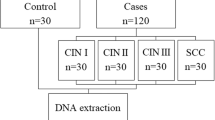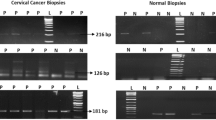Abstract
Cervical cancer is the most common cancer among women in India and a leading cause of death in these women. Most cases of cervical cancer are associated with human papillomavirus (HPV) infection of the high-risk type. It has been reported that aberrant DNA methylation can be associated with HPV infection and cervical cancer, and folate is directly involved in DNA methylation via one-carbon metabolism. We aimed to study the importance of one-carbon metabolism in the progression of cervical carcinogenesis by examining serum levels of vitamin B12 (cobalamin), homocysteine, and folate and DNA methylation of tumor suppressor genes CDH1, HIC1, and Retinoic acid receptor beta (RARβ) amid these women ranging from normal to squamous intraepithelial neoplastic lesions (SIL) to cervical cancer. Blood and tissue samples were collected from normal (n = 35), SILs (n = 27), and cervical cancer patients (n = 38) in the age group of 26–70 years. Measurement of serum vitamin B12, folate, and homocysteine were done using kits (Immulite). Promoter methylation was examined using methylation-specific PCR. The frequency of promoter hypermethylation for all the three tumor suppressor genes CDH1, HIC1, and RARβ showed an increasing trend from normal to dysplastic to invasive cervical cancer (p < 0.05). We observed that lower folate and vitamin B12 status were associated with HPV infection. Taken together, our findings suggest a role of folate and vitamin B12 in modulating the risk of cervical cancer and HPV infection. CDH1, HIC1, and RARβ genes can be used as potential biomarkers of cervical cancer risk assessment.

Similar content being viewed by others
References
Jemal A, Bray F, Center MM, Ferlay J, Ward E, Forman D (2011) Global cancer statistics. CA Cancer J Clin 61:69–90
Ferlay J, Shin HR, Bray F, Forman D, Mathers C, Parkin DM (2010) GLOBOCAN 2008 v1.2, Cancer Incidence and Mortality Worldwide: IARC CancerBase No. 10. [Internet]. Lyon, France: International Agency for Research on Cancer; 2010. http://globocan.iarc.fr.
Schiffman MH, Castle P (2003) Epidemiologic studies of a necessary causal risk factor: human papillomavirus infection and cervical neoplasia. J Natl Cancer Inst 95:E2
Ostor AG (1993) Natural history of cervical intraepithelial neoplasia: a critical review. Int J Gynecol Pathol 12:186–192
Virmani AK, Muller C, Rathi A, Zoechbauer-Mueller S, Mathis M, Gazdar AF (2001) Aberrant methylation during cervical carcinogenesis. Clin Cancer Res 7:584–589
Wentzensen N, Sherman ME, Schiffman M, Wang SS (2009) Utility of methylation markers in cervical cancer early detection: appraisal of the state-of-the-science. Gynecol Oncol 112:293–299
Powers HJ (2005) Interaction among folate, riboflavin, genotype, and cancer, with reference to colorectal and cervical cancer. J Nutr 135:2960S–2966S
Piyathilake CJ, Henao OL, Macaluso M et al (2004) Folate is associated with the natural history of high-risk human papillomaviruses. Cancer Res 64:8788–8793
Piyathilake CJ, Macaluso M, Brill I, Heimburger DC, Partridge EE (2007) Lower red blood cell folate enhances the HPV-16-associated risk of cervical intraepithelial neoplasia. Nutrition 23:203–210
Hughes JP, Garnett GP, Koutsky L (2002) The theoretical population-level impact of a prophylactic human papillomavirus vaccine. Epidemiology 13:631–639
Kulasingham SL, Myers ER (2003) Potential health and economic impact of adding a human papillomavirus vaccine to screening programs. JAMA 290:781–789
Trimble CL, Peng S, Kos F, Gravitt P, Viscidi R, Sugar E et al (2009) A phase I trial of a human papillomavirus DNA vaccine for HPV16 + cervical intraepithelial neoplasia 2/3. Clin Cancer Res 15:361–367
Chandra S, Chandra RK (1986) Nutrition, immune response, and outcome. Prog Food Nutr Sci 10:1–65
Dhur A, Galan P, Hercberg S (1991) Folate status and the immune system. Prog Food Nutr Sci 15:43–60
Ahluwalia N, Mastro AM, Ball R, Miles MP, Rajendra R, Handte G (2001) Cytokine production by stimulated mononuclear cells did not change with aging in apparently healthy, well-nourished women. Mech Ageing Dev 122:1269–1279
Kim YI, Hayek M, Mason JB, Meydani SM (2002) Severe folate deficiency impairs natural killer cell-mediated cytotoxicity in rats. J Nutr 132:1361–1367
Piyathilake CJ, Badiga S, Paul P, Vijayaraghavan K, Vedantham H, Sudula M, Sowjanya P, Ramakrishna G, Shah KV, Partridge EE, Gravitt PE (2010) Indian women with higher serum concentrations of folate and vitamin B12 are significantly less likely to be infected with carcinogenic or high-risk (HR) types of human papillomaviruses (HPVs). Int J Womens Health 9:7–12
Narayan G, Arias-Pulido H, Koul S, Vargas H, Zhang FF, Villella J, Schneider A, Terry MB, Mansukhani M, Murty VV (2003) Frequent promoter methylation of CDH1, DAPK, RARB, and HIC1 genes in carcinoma of cervix uteri: its relationship to clinical outcome. Mol Cancer 13(2):24
Datta P, Bhatla N, Dar L, Patro AR, Gulati A, Kriplani A, Singh N (2010) Prevalence of human papillomavirus infection among young women in North India. Cancer Epidemiol 34:157–161
Singh A, Datta P, Jain SK, Bhatla N, Dutta Gupta S, Dey B, Singh N (2009) Human papilloma virus genotyping, variants and viral load in tumors, squamous intraepithelial lesions, and controls in a north Indian population subset. Int J Gynecol Cancer 19:1642–1648
Flatley JE, McNeir K, Balasubramani L, Tidy J, Stuart EL, Young TA, Powers HJ (2009) Folate status and aberrant DNA methylation are associated with HPV infection and cervical pathogenesis. Cancer Epidemiol Biomarkers Prev 18:2782–2789
Bender DA (2003) Nutritional biochemistry of the vitamins, 2nd edn. Cambridge University Press, Cambridge
Esteller M (2007). Epigenetic gene silencing in cancer: the DNA hypermethylome. Hum Mol Genet 16 Spec No 1:R50–59
Wilke CM, Hall BK, Hoge A, Paradee W, Smith DI, Glover TW (1996) FRA3B extends over a broad region and contains a spontaneous HPV 16 integration site: direct evidence for the coincidence of viral integration sites and fragile sites. Hum Mol Genet 5:187–195
Popescu NC, DiPaolo JA, Amsbaugh SC (1987) Integration sites of human papillomavirus 18 DNA sequences on HeLa cell chromosomes. Cytogenet Cell Genet 44:58–62
Piyathilake CJ, Henao OL, Meleth S, Partridge E, Heimburger D (2003) Folate is associated with the acquisition, persistence and clearance of high-risk (HR) human papillomavirus (HPV). FASEB J 17:A373
Park IS, Chang X, Loyo M, Wu G, Chuang A, Kim MS, Chae YK, Lyford-Pike S, Westra WH, Saunders JR, Sidransky D, Pai SI (2011) Characterization of the methylation patterns in human papillomavirus type 16 viral DNA in head and neck cancers. Cancer Prev Res (Phila) 4:207–217
Sun C, Reimers LL, Burk RD (2011) Methylation of HPV16 genome CpG sites is associated with cervix precancer and cancer. Gynecol Oncol 12:59–63
Esteller M, Corn PG, Baylin SB, Herman JG (2001) A gene hypermethylation profile of human cancer Cancer Res 61:3225–3229
Strathdee G (2002) Epigenetic versus genetic alterations in the inactivation of E-cadherin Semin. Cancer Biol 12:373–379
Bornman DM, Mathew S, Alsruhe J, Herman G, Gabrielson (2001) Methylation of E-cadherin gene in bladder neoplasia and in normal urothelial epithelium from elderly individuals. Am J Pathol 159(3):831–835
Wales MM, Biel MA, el Deiry W, Nelkin BD, Issa JP, Cavenee WK, Kuerbitz SJ, Baylin SB (1995) p53 activates expression of HIC-1, a new candidate tumour suppressor gene on 17p13.3. Nat Med 1:570–577
Wasson GR, McGlynn AP, McNulty H et al (2006) Global DNA and p53 region-specific hypomethylation in human colonic cells is induced by folate depletion and reversed by folate supplementation. J Nutr 136:2748–2753
Author information
Authors and Affiliations
Corresponding author
Rights and permissions
About this article
Cite this article
Pathak, S., Bhatla, N. & Singh, N. Cervical cancer pathogenesis is associated with one-carbon metabolism. Mol Cell Biochem 369, 1–7 (2012). https://doi.org/10.1007/s11010-012-1362-3
Received:
Accepted:
Published:
Issue Date:
DOI: https://doi.org/10.1007/s11010-012-1362-3




